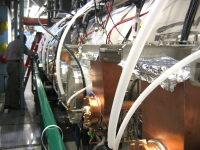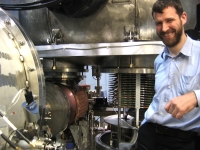 |
 |
|||||||||||||
|
|||||||||||||
|
|||||||||||||
|
In a linear accelerator, energy conservation is not really on the achievement list. To get up to the required luminosity, accelerator experts have one chance to push the particle beams to their limits, putting much energy into the bunches, correcting, scraping and tweaking them along the way only to smash them into each other and direct the straggly remains into a dump. Not so an Energy Recovery Linac, currently at the design and first prototype stage at Cornell University. The electron beams also get dumped after one run, but before that happens, they are tricked into handing over their energy back to the superconducting machine that accelerated them.
The Energy Recovery Linac, or ERL, could be the world's next high-efficiency X-ray light source with beams brighter, more coherent and with better pulse duration than existing light sources because of its low emittances. It would open the door to new research into materials and biological and chemical processes down to the nanoscale. The first prototype injector set-up, consisting of electron gun, superconducting injector cryomodule and diagnostics, has been assembled and is being tested at the moment at Cornell's Wilson Laboratory. “We are trying to prove the principle of producing extremely bright electron beams, and with our first beam passing through the set-up things are looking good,” says Georg Hoffstaetter. The complete ERL would accelerate electrons with superconducting rf power in a 650-metre linac to an energy of up to 5 GeV. They would then be sent onto a path around the existing CESR storage ring, during which they emit the synchrotron radiation that researchers are looking for. Instead of circling the ring several times, however, the bunches of electrons would only take one turn, fly back into the linac and "hand over" their energy to the electromagnetic field inside superconducting cavities before ending their short life in a beam dump. There recovered energy is then available to accelerate new bunches of electrons. “When beams of electrons travel many times around CESR, they tend to spread out, diminishing the brightness and focus of the beam,” explains Hoffstaetter. “By supplying energy in one long straight-line followed by only one trip around the ring, the ERL will produce a brighter, narrower beam.” During the recovery process the beam energy goes down from 5 GeV to 10 MeV. Superconducting cavities are used to accelerate particles with precision timing. This process can be reversed by forcing the electrons to paddle against the radiofrequency wave rather than ride on it. While doing that they hand over their energy to the field. “This allows the acceleration of much larger currents than otherwise possible and increases the science output. We dump a one-megawatt beam while having a 500 megawatt beam available for x-ray production,” Hoffstaetter says. Only superconducting cavities can do this job because normal conducting ones would become too hot under the constant high-field operation. Another challenge are the 1.3 billion pulses per second needed for the facility. “With our prototype injector we will show that this can be achieved.” Similar facilities are being planned at the Advanced Photon Source at Argonne National Lab in the US and at KEK in Japan, but Cornell so far has the only running prototype injector. The project received 18 million dollars from the National Science Foundation in 2005. The current test and expected results are the culmination of the four-year test period. The next step: trying to get funding for the full light source. -- Barbara Warmbein |
|||||||||||||
| © International Linear Collider |

